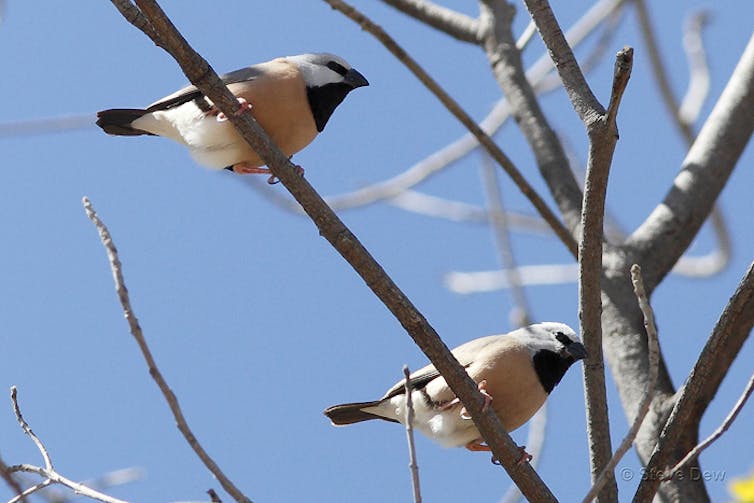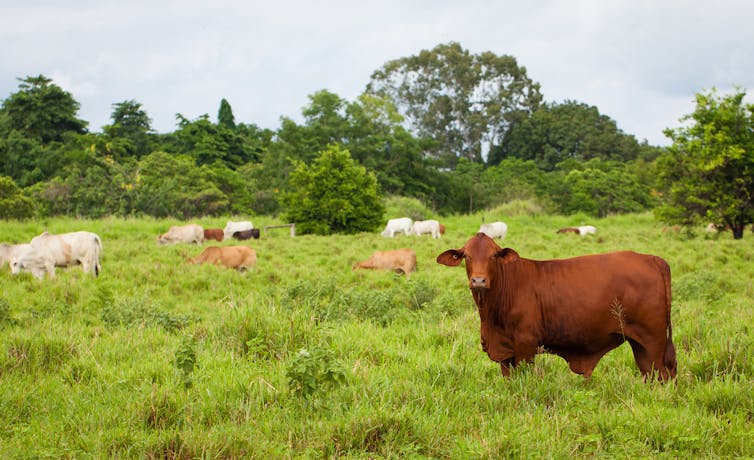Why Adani's finch plan was rejected, and what comes next
- Written by Samantha Hepburn, Director of the Centre for Energy and Natural Resources Law, Deakin Law School, Deakin University
Adani’s plan to manage an endangered finch was rejected last week by the Queensland government, stalling progress on the Carmichael mine.
The mine would cover much of the best remaining habitat for the endangered black-throated finch. The Queensland government required Adani to commit to gathering more accurate finch population data, limit the cattle grazing in the finch conservation area and determine food availability throughout the year, before they could approve the plan.
The rejection is one of two outstanding environmental approvals required before Adani can commence work on the mine. The second is the plan to manage groundwater-dependent ecosystems, which the Queensland government has yet to come to a decision on.
Read more: Unpacking the flaws in Adani's water management plan
The federal government has been reported as “already approving” the finch plan. But legally, the Queensland government must determine whether the plan complies with the conditions of the environmental authority and, under the bilateral framework, the federal government must give due regard to this assessment.
What’s wrong with Adani’s plan?
Last Friday Queensland’s Department of Environment and Science decided not to approve Adani’s black-throated finch management plan because it does not fulfil certain basic requirements.
The decision is based on a detailed report from an independent expert panel.
The black-throated finch is on the verge of extinction, one of 238 threatened Australian birds.
 The black-throated finch is experiencing habitat loss and degradation.
Steve Dew/flickr, CC BY
The black-throated finch is experiencing habitat loss and degradation.
Steve Dew/flickr, CC BY
Read more: For the first time we've looked at every threatened bird in Australia side-by-side
The greatest threat to the black-throated finch is habitat loss: it has disappeared from over 80% of its original range. Strong protection, and careful management, of its remaining habitat is crucial.
The finch, once found across north-eastern Australia, is now largely found on Moray Downs and surrounding properties, north-west of Clermont in central Queensland. A core part of the habitat is within the 28,000 hectare (ha) footprint of the Carmichael mine, where there are far more black finches than elsewhere due to the intact woodlands and a history of minimal livestock grazing.
It is expected the mines will disturb 50,977 ha of black-throated finch habitat, and that 34,156 ha will be completely cleared.
A total of 87 square kilometres of habitat will be destroyed through the creation of open pits, and a further 61 square kilometres may be degraded beyond repair due to the influence of underground mining on groundwater.
After habitat loss, the second greatest threat to the finch is cattle grazing, which destroys the grass seeds they need to survive. Yet Adani’s management plan for the black-throated finch involved grazing cattle on areas that are supposed to be devoted to conservation of the finch.
Instead of establishing a finch conservation reserve, the Adani plan proposed what was in effect a paddock. Providing a species management plan that effectively conserves finch habitat is a core condition of Adani’s mining licence.
State vs federal priorities
The Queensland government’s rejection of the plan brings into stark focus some of the problems with the existing environmental assessment framework.
 The Adani plan includes cattle grazing, despite the threat to finch habitats.
Shutterstock
The Adani plan includes cattle grazing, despite the threat to finch habitats.
Shutterstock
The environmental authority for the mining licence was approved by the Federal government. The environmental management plan for the finch did not, however, address core impact concerns. And yet this is the very reason that the plan was required from the outset. The inadequacies of the plan only became apparent because of the oversight of the Queensland government.
The federal government has not been proactive despite’s its mandate under our National environment act - the Environmental Protection Biodiversity Conservation act. In fact, a recent analysis found the federal government has approved hundreds of projects to clear black-throated finch habitat over the last 18 years.
Read more: Death by 775 cuts: how conservation law is failing the black-throated finch
There are clearly differences in priorities regarding the environment between a federal Liberal and a state Labor government. However, environmental assessment can only be effective if is not undermined by political agendas, and is grounded in scientific rigour and scrutiny.
A one-stop shop
At the federal level, any project likely to have a “significant impact” on a matter protected by the Environment Protection and Biodiversity Conservation Act must be referred to the federal environment minister.
If the minister decides the project impacts a matter of national environmental significance, he or she will then determine how to assess that project at the national level. Legislated options include: an environmental impact statement, a public environment report and public inquiry.
The federal government has entered into bilateral agreements with all state and territory governments. As a result, rather than the state and federal governments conducting separate assessment, the aim is to promote a single, focused environmental evaluation.
The Queensland government has entered into a bilateral assessment agreement with the Commonwealth government for Adani’s coal project, which effectively allows it to make an environmental assessment that the Commonwealth Minister will then take account of when deciding whether to grant approval.
This means that both the Queensland and the federal government are involved in the approval and assessment process environmental authorities and conditions, one of those being the management plan for the black-throated finch. In order to optimise outcomes they need to work together collaboratively.
Where to next?
The rejection means that Adani will now need to submit a new or revised plan that addresses the Queensland government’s concerns. In particular, Adani will need to limit cattle grazing in the conservation area, and gather more information regarding the availability of seed throughout the year.
This may take time but is critical, because in its current form, the plan does not meet the legal requirements for the Environmental Authority, which means that it cannot be approved at the state level.
Without state approval the Adani coal mine cannot proceed. The Queensland government has rigorously assessed Adani’s management plan by commissioning a report by an independent expert panel and then acting on the advice of this report.
This robust approach is crucial to the whole framework of environmental assessment. Genuine commitment to protecting endangered species and managing vital groundwater resources is vital if we want to reverse Australia’s dire trajectory of environmental decline.
Authors: Samantha Hepburn, Director of the Centre for Energy and Natural Resources Law, Deakin Law School, Deakin University
Read more http://theconversation.com/why-adanis-finch-plan-was-rejected-and-what-comes-next-116525





